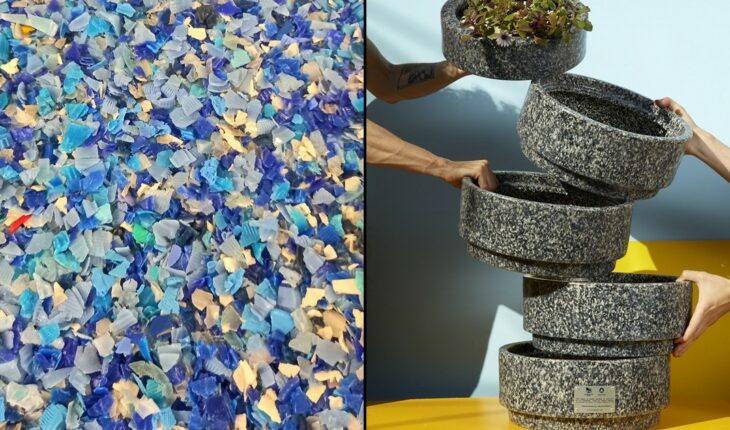Maybe you thought the best thing you could do for the environment was to recycle, but there are even more useful and time-consuming actions. Something key when it comes to helping the planet is to take into account the three R’s of ecology: reduce, reuse and recycle. According to data provided by the Ministry of Environment and Sustainable Development, on average each Argentine produces 1.15 kg of solid waste per day, which per month means more than 34kg, and per year almost 408 kg. 408kg per person per year. That’s not counting the waste of businesses, services, or industries. Recycling is a half-baked solution because it needs resources to complete the cycle. By recycling we reduce much more than the garbage that will go to an incinerator, or worse, that will end up in the oceans or forests. Before recycling, it is recommended to reduce consumption and reuse resources as much as possible.
Did you know that manufacturing from recycled packaging implies energy savings of between 75% and 95%? This happens because the amount of raw material we need (and the expense involved in its production) is reduced and resources such as electricity and water are saved. For all these reasons, we need to become responsible consumers. It basically means thinking before you buy. “It is about doing more and better with less”, they explain from Consumers International and clarify that there is no single way to do it: “It can be the reconsideration of a purchase and instead reuse something already existing or choose a product with a beneficial impact on the environment or at a social level”.
Can you imagine if we could “transform” our waste into useful things? Drinks caps turned into glasses, tires on slippers, pieces of old clothes in caps… These entrepreneurs looked for a sustainable alternative and managed to turn that “garbage” into their raw material. Textile discards and silobags
Delfina Sciurano was about to graduate as a clothing designer when she noticed how “harmful and horrible” that industry was. So she decided to do things her way so she could feel comfortable working from what she liked and Ékdysis was born: backpacks, bags, fanny packs and other products made from silobags.” Silobag is a high-density polyethylene material, which is used in fields for grain storage. It is used once during the reserve period and then discarded, burned, buried and rarely sent for recycling or reselling. We also reuse textile discards from the textile industry, the second most polluting in the world. From that we generate the lining of our products, “delfina told Filo.news.
Instagram @ekdysis.design
FOH Hats in the brand of Felipe Hurtado. He is the creator, designer, seamstress and seller of this venture of caps made with clothes that are no longer used: “I started in 2013 from the living room of my house. I made caps but not reusing fabrics. In 2018 I put everything aside and resumed in 2020 in the Netherlands.” When he could not find a job, he resumed his old cap project: “I found in the field of upcycling a very large acceptance and a young audience that is interested. There are still not many brands and entrepreneurs that can solidify those ideals and that need. I like to think that I’m striving and working hard to close that gap more and more.” Plastic caps and packages
Materas, cell phone holders and wallets are some of the products they make in Itupai with single-use bags and sachets. “We use polyethylene containers, those that are represented with the triangle and a 2 or 4 in the center. The advantage is that they merge with high temperatures. Through thermofusion we create a kind of plastic fabric. This material is resistant, waterproof, has a long service life and does not need chemicals or dyes to obtain it,” said Agustina Melendi.In Itupai they work together with their community to obtain their raw material: “We used our own discards at the beginning. Currently we raise large plastic wrappers that we see on the street, at fairs we ask our followers to take their plastic waste and we talk to sports venues in our area to give us the bags in which the clothes that are discarded arrive as soon as they put them on display. ”
In Necológica they also work with plastics from household waste such as lavender bottles or shampoo containers. Ingrid (graduated in Environmental Management) and Ezequiel (industrial designer) buy the protected workshop “Todo para ellos” of Necochea, discards from companies and other municipalities in that area. With that they assemble plastic plates that are the basis for their products: mouse tables, armchairs, cupboards, bases for cell phones and computers, banks, shuffleboard games, among other products.” We notice that when people see our products and understand that they are made from waste, they drop the tab on the importance of separating waste. It changes their perception of waste as garbage and they begin to see it as a resource,” the founders told Filo.news. They highlighted that they started in Necochea in May 2019 as a space for awareness on environmental issues and that today it was transformed into a more federal project with a fusion between design and care for the planet.
Instagram @proyectomutan
Another of the brands that works with this materal is Mutan: “We use beverage caps that people from all over the country separate and donate to different foundations and cooperatives. We bought them from them,” explained Brochi Fasani, creator and coordinator of the project. In Mutan you can find everything from furniture such as lamps, tables and pots to sunglasses and reading glasses, through baskets and compost bins.” From the beginning we seek to be a proposal of high industrial quality and without being more expensive than non-recycled, trying to be an alternative for anyone who would like to consume consciously. In recent years the environmental awareness of consumers has grown, especially in the pandemic, and many more people today compost in their homes and opt for recycled products, “they recognized from Mutan.En DosPuntos they also buy plastic caps from Garrhan and also use industrial discards of bags and the automotive industry: “We develop and market various products made with recycled material such as lamps, notebooks, cartridge cases, bags, covers for compu and tablets. We have our own line, and we make on-demand developments for companies and institutions,” said partner, founder and designer Dario Mercuri.
Instagram @dospuntosdi
“We noticed good acceptance when we started, many people were surprised by the materials we used and the quality we achieved with waste that had no value, and that we turned into resources. There is more and more awareness in shopping, and therefore greater knowledge and desire for products that have triple impact. On the part of companies, the same thing happens. Many seek to migrate their business gifts to sustainable products. Consumer education is key to having more criteria to choose from, that’s why we also seek to make it evident in our products the discards we use, so that they carry that message that it is possible to transform waste into products, “he closed about this project. Industrial tyres and discards
At Leaf they focus on the transformation of industrial discards to create eco-bags, ecomochilas, eco-wallets and many more eco-products that solve packaging and merchandising needs of large companies. “We make products that make a difference and invite us to be the protagonist of change. In the production of our products we generate job opportunities and social inclusion for young people with intellectual disabilities who are part of the mold cutting process, women in vulnerable situations who as seamstresses are the economic sustenance of their families. We also function as a source of social reintegration for people who were released after having served their sentence,” they explained.
For their products they use recycled materials such as tire rubber, disused advertising banners, big bags, silobags, nautical sails, malt bags, various textiles and many more. “We obtain the materials through agreements with the same companies that discard them. It allows companies to be protagonists of change by buying merchandasing, business gifts or packaging made with recycled materials. Thus they multiply the scope of the social impact of the purchase, increase their CSR, and therefore their image before their customers.” With our proposal, discarding ceases to be a problem and becomes useful both to solve needs and to communicate values linked to the care of the environment. Recycling requires 70% less energy and emits 59% less greenhouse gases, largely responsible for climate change. We are convinced that the future lies in the reuse of plastic waste as opposed to the current use at once”, they said from Leaf.From Mutan they wanted to take the opportunity to make a thank you to continue motivating those who recycle: “Those who separate plastics in their homes are part of our production process. We like to know that our products can go back to the homes of those who started the process and help them transform their discards into compost bins or change the way plastics look with our lenses.”
Let’s be clear that recycling is the last option and there are a lot of things we can do before. Becoming responsible consumers is the first thing we need to do. Once we have that mindset we will know what to buy, what to look for and who to buy from. As consumers we have a responsibility to demand from the big brands and the knowledge to opt for brands that have a positive impact on the planet and on our society. A large part of the interviewees are part of the apparel industry and all wanted to highlight in their testimony to Filo.news that it is the second most polluting industry in the world. It’s the worst after oil… That is why it is so important that as consumers we look for alternatives in this area. Let’s rotate clothes among friends, buy second-hand clothes, take care of what we already have. There are many options to avoid contributing to fast fashion.





